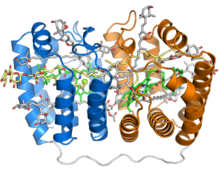


| |

| |
| Names | |
|---|---|
| IUPAC name
Acetic acid [(1S,3R)-3-hydroxy-4-[(3E,5E,7E,9E,11Z)-11-[4-[(E)-2-[(1S,4S,6R)-4-hydroxy-2,2,6-trimethyl-7-oxabicyclo[4.1.0]heptan-1-yl]vinyl]-5-oxo-2-furylidene]-3,10-dimethylundeca-1,3,5,7,9-pentaenylidene]-3,5,5-trimethylcyclohexyl] ester | |
| Identifiers | |
3D model (JSmol) |
|
PubChem CID |
|
CompTox Dashboard (EPA) |
|
| |
| Properties | |
| C39H50O7 | |
| Molar mass | 630.822 g·mol−1 |
Except where otherwise noted, data are given for materials in their standard state (at 25 °C [77 °F], 100 kPa). | |
Peridinin is a light-harvesting apocarotenoid, a pigment associated with chlorophyll and found in the peridinin-chlorophyll-protein (PCP) light-harvesting complexindinoflagellates, best studied in Amphidinium carterae.[1]

Peridinin is an apocarotenoid pigment that some organisms use in photosynthesis. Many photosynthetic dinoflagellates use peridinin, which absorbs blue-green light in the 470-550nm range, outside the range accessible to chlorophyll molecules. The peridinin-chlorophyll-protein complex is a specialized molecular complex consisting of a boat-shaped protein molecule with a large central cavity that contains peridinin, chlorophyll, and lipid molecules, usually in a 4:1 ratio of peridinin to chlorophyll.[2][3][4]

Peridinin chlorophyll (PerCP) is commonly used in immunoassays such as fluorescence-activated cell sorting (FACS) and flow cytometry. The fluorophore is covalently linked to proteins or antibodies for use in research applications.[5]
|
| |
|---|---|
| Carotenes (C40) |
|
| Xanthophylls (C40) |
|
| Apocarotenoids (C<40) |
|
| Vitamin A retinoids (C20) |
|
| Retinoid drugs |
|